 The Kellogg Farmers Study Program established agricultural leadership programs in 1965. Today these programs, which are part of the International
The Kellogg Farmers Study Program established agricultural leadership programs in 1965. Today these programs, which are part of the International
Association of Programs for Agricultural Leadership, are used around the world to develop leaders for “continued or future service to their
community—rural, agricultural, or otherwise.” This 3-page fact sheet was written by Hannah Carter and Avery Culbertson, and published by the UF Department of Agricultural Education and Communication, October 2012.
http://edis.ifas.ufl.edu/wc121
Author: dihagan
The Wedgworth Leadership Institute for Agriculture and Natural Resources (WC120)
 The Wedgworth Leadership Institute for Agriculture and Natural Resources (WLIANR) develops and refines the leadership capabilities of leaders involved in Florida agriculture and natural resources. These leaders are prepared to become increasingly involved in forming policies that affect the future of Florida agriculture and natural resources in a direct or indirect manner. This 2-page fact sheet was written by Hannah Carter and Rochelle Strickland, and published by the UF Department of Agricultural Education and Communication, October 2012.
The Wedgworth Leadership Institute for Agriculture and Natural Resources (WLIANR) develops and refines the leadership capabilities of leaders involved in Florida agriculture and natural resources. These leaders are prepared to become increasingly involved in forming policies that affect the future of Florida agriculture and natural resources in a direct or indirect manner. This 2-page fact sheet was written by Hannah Carter and Rochelle Strickland, and published by the UF Department of Agricultural Education and Communication, October 2012.
http://edis.ifas.ufl.edu/wc120
Cutting Costs to Live Within Your Income (FCS7009/HE153)
 Developing self-control of your spending is a basic step in cutting the cost of living. Some families are able to afford what they want, even on a limited income. This may result from having more experience or greater skills. You probably know specific things you could do to reduce spending. These suggestions may work for you. This 3-page fact sheet was written by Josephine Turner, Michael S. Gutter, and Nayda I. Torres, and published by the UF Department of Family Youth and Community Sciences, October 2012.
Developing self-control of your spending is a basic step in cutting the cost of living. Some families are able to afford what they want, even on a limited income. This may result from having more experience or greater skills. You probably know specific things you could do to reduce spending. These suggestions may work for you. This 3-page fact sheet was written by Josephine Turner, Michael S. Gutter, and Nayda I. Torres, and published by the UF Department of Family Youth and Community Sciences, October 2012.
http://edis.ifas.ufl.edu/he153
Florida Reclaimed Phosphate Mine Soils: Characteristics, Potential Uses, and Management Considerations (SL370/SS571)
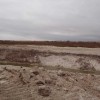 A critical nutrient for plant growth, phosphate helps sustain the world’s growing population. In 2010, seven mines in Florida produced approximately 10% of the world’s phosphate supply and more than 65% of the phosphate for the United States. But each year in Florida thousands of acres disturbed by strip-mining for phosphate rock must be reclaimed for other productive uses. This 11-page fact sheet provides a general characterization of the various soil types resulting from phosphate mine reclamation. Written by M. Wilson and E.A. Hanlon, and published by the UF Department of Soil and Water Science, October 2012.
A critical nutrient for plant growth, phosphate helps sustain the world’s growing population. In 2010, seven mines in Florida produced approximately 10% of the world’s phosphate supply and more than 65% of the phosphate for the United States. But each year in Florida thousands of acres disturbed by strip-mining for phosphate rock must be reclaimed for other productive uses. This 11-page fact sheet provides a general characterization of the various soil types resulting from phosphate mine reclamation. Written by M. Wilson and E.A. Hanlon, and published by the UF Department of Soil and Water Science, October 2012.
http://edis.ifas.ufl.edu/ss571
Alternative Greenhouse Crops: Florida Greenhouse Vegetable Production Handbook, Vol 3 (HS791/CV272)
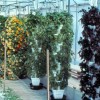 In 2012, it was estimated that 500 acres or more of all edible crops were being grown in some type of protected culture in Florida. This 13-page fact sheet discusses some of the alternative or specialty crops being grown and marketed. Written by R. Hochmuth and D. Cantliffe, and published by the UF Department of Horticultural Sciences, October 2012.
In 2012, it was estimated that 500 acres or more of all edible crops were being grown in some type of protected culture in Florida. This 13-page fact sheet discusses some of the alternative or specialty crops being grown and marketed. Written by R. Hochmuth and D. Cantliffe, and published by the UF Department of Horticultural Sciences, October 2012.
http://edis.ifas.ufl.edu/cv272
New Hydrangeas for North and Central Florida: Bigleaf and Mountain Hydrangeas (ENH1034/EP287)
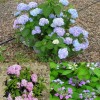 Discoveries of reflowering hydrangeas have resulted in the introduction of many new cultivars, providing more garden impact and strengthening ongoing hydrangea appreciation. Even prior to the new reflowering cultivars, gardeners and landscapers had renewed interest in hydrangeas because they flower in shade, often produce blue flowers, and are considered an “heirloom” plant that reminds us of the garden heritage of our forefathers. Many of the newer cultivars have superior form and disease resistance, and some provide 15 or more weeks of flowering per year in north Florida. This 5-page fact sheet was written by Gary W. Knox, and published by the UF Department of Environmental Horticulture, September 2012.
Discoveries of reflowering hydrangeas have resulted in the introduction of many new cultivars, providing more garden impact and strengthening ongoing hydrangea appreciation. Even prior to the new reflowering cultivars, gardeners and landscapers had renewed interest in hydrangeas because they flower in shade, often produce blue flowers, and are considered an “heirloom” plant that reminds us of the garden heritage of our forefathers. Many of the newer cultivars have superior form and disease resistance, and some provide 15 or more weeks of flowering per year in north Florida. This 5-page fact sheet was written by Gary W. Knox, and published by the UF Department of Environmental Horticulture, September 2012.
http://edis.ifas.ufl.edu/ep287
Casuarina equisetifolia, Australian Pine (FOR298/FR366)
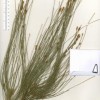 Australian pine was originally planted in Florida in the late 1800’s as a windbreak and for shade. But soon thereafter it was spreading without help from humans. Today it is considered a category I invasive species in Florida, and the Division of Plant Industry strictly prohibits possessing, transporting, and cultivating this species. For those who find this tree in close proximity to their home, it’s a good idea to replace it since Australian pine is known to have a very low resistance to wind. Australian pine is commonly found growing on coastal shorelines since it thrives in salty, sandy environments. This 2-page fact sheet was written by Michael G. Andreu, Melissa H. Friedman, and Robert J. Northrop, and published by the UF Department of School of Forest Resources and Conservation, July 2012.
Australian pine was originally planted in Florida in the late 1800’s as a windbreak and for shade. But soon thereafter it was spreading without help from humans. Today it is considered a category I invasive species in Florida, and the Division of Plant Industry strictly prohibits possessing, transporting, and cultivating this species. For those who find this tree in close proximity to their home, it’s a good idea to replace it since Australian pine is known to have a very low resistance to wind. Australian pine is commonly found growing on coastal shorelines since it thrives in salty, sandy environments. This 2-page fact sheet was written by Michael G. Andreu, Melissa H. Friedman, and Robert J. Northrop, and published by the UF Department of School of Forest Resources and Conservation, July 2012.
http://edis.ifas.ufl.edu/fr366
Pyrus communis, Common Pear (FOR293/FR361)
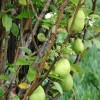 The showy flowers and manageable height of common pear makes it a favorable ornamental landscape tree. Some find the aromatic flowers and sweet edible fruits to be an additional plus; however, a pollinator specimen must be nearby in order for the female tree to produce fruit. Careful consideration should be taken when choosing a planting location, since the soft fruits can be messy if not harvested. This 2-page fact sheet was written by Michael G. Andreu, Melissa H. Friedman, and Robert J. Northrop, and published by the UF Department of School of Forest Resources and Conservation, July 2012.
The showy flowers and manageable height of common pear makes it a favorable ornamental landscape tree. Some find the aromatic flowers and sweet edible fruits to be an additional plus; however, a pollinator specimen must be nearby in order for the female tree to produce fruit. Careful consideration should be taken when choosing a planting location, since the soft fruits can be messy if not harvested. This 2-page fact sheet was written by Michael G. Andreu, Melissa H. Friedman, and Robert J. Northrop, and published by the UF Department of School of Forest Resources and Conservation, July 2012.
http://edis.ifas.ufl.edu/fr361
Horn Fly Management (ENY288/IN952)
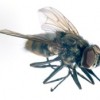 Horn flies are one of the livestock pests with the greatest impact on the health and productivity of cattle. Economic losses due to horn fly damage are estimated at $36 million annually in Florida alone. In the U.S.A. annual losses total between $700 million and $1 billion, with up to $60 million spent on insecticidal control. Horn fly damage is caused by blood feeding. The flies feed frequently and exclusively on blood, piercing the skin of cattle with their proboscis and taking around 20 small blood meals each day. Pain and irritation due to the constant presence of the flies and their bites causes defensive behavior in the cattle that prevents adequate food consumption and rest. This 4-page fact sheet was written by P. E. Kaufman and E. N. I. Weeks, and published by the UF Department of Entomology and Nematology, September 2012.
Horn flies are one of the livestock pests with the greatest impact on the health and productivity of cattle. Economic losses due to horn fly damage are estimated at $36 million annually in Florida alone. In the U.S.A. annual losses total between $700 million and $1 billion, with up to $60 million spent on insecticidal control. Horn fly damage is caused by blood feeding. The flies feed frequently and exclusively on blood, piercing the skin of cattle with their proboscis and taking around 20 small blood meals each day. Pain and irritation due to the constant presence of the flies and their bites causes defensive behavior in the cattle that prevents adequate food consumption and rest. This 4-page fact sheet was written by P. E. Kaufman and E. N. I. Weeks, and published by the UF Department of Entomology and Nematology, September 2012.
http://edis.ifas.ufl.edu/in952
Are You Marrying Someone from a Different Culture or Religion? (FCS2321/FY1337)
 It was the author Paul Sweeney who penned, “A wedding anniversary is the celebration of love, trust, partnership, tolerance, and tenacity. The order varies for any given year.” Couples must make many adjustments as they learn to live with each other from year to year. When those adjustments include negotiating culture or religion, it adds another dimension to the process of trying to strengthen the relationship. This 7-page fact sheet was written by Stephanie C. Toelle and Victor W. Harris, and published by the UF Department of Family Youth and Community Sciences, September 2012.
It was the author Paul Sweeney who penned, “A wedding anniversary is the celebration of love, trust, partnership, tolerance, and tenacity. The order varies for any given year.” Couples must make many adjustments as they learn to live with each other from year to year. When those adjustments include negotiating culture or religion, it adds another dimension to the process of trying to strengthen the relationship. This 7-page fact sheet was written by Stephanie C. Toelle and Victor W. Harris, and published by the UF Department of Family Youth and Community Sciences, September 2012.
http://edis.ifas.ufl.edu/fy1337
2012 Florida Constitutional Amendments series
 In addition to 2012 being a presidential election year, Florida voters also will be asked to vote on a number of proposed amendments to their state constitution. Many voters remain either unaware or less informed regarding the effects and impacts of the proposed constitutional amendments. This series of 6 fact sheets was written by Rodney L. Clouser, and published by the UF Department of Food and Resource Economics, July 2012.
In addition to 2012 being a presidential election year, Florida voters also will be asked to vote on a number of proposed amendments to their state constitution. Many voters remain either unaware or less informed regarding the effects and impacts of the proposed constitutional amendments. This series of 6 fact sheets was written by Rodney L. Clouser, and published by the UF Department of Food and Resource Economics, July 2012.
- Amendment 2: Veterans Disabled Due to Combat Injury; Homestead Property Tax Discount
- Amendment 3: State Government Revenue Limitation
- Amendment 4: Property Tax Limitations; Property Value Decline; Reduction for Nonhomestead Assessment Increases, Delay of Scheduled Repeal
- Amendment 9: Homestead Property Tax Exemption for Surviving Spouse of Military Veteran or First Responder
- Amendment 10: Tangible Personal Property Tax Exemption
- Amendment 11: Additional Homestead Exemption; Low-Income Seniors Who Maintain Long-Term Residency on Property; Equal to Assessed Value
http://edis.ifas.ufl.edu/topic_2012_florida_constitutional_amendments
Tabebuia serratifolia, Yellow Trumpet Tree (FOR303/FR371)
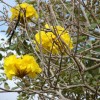 This deciduous tree is native to South and Central America is commonly planted in Florida as an ornamental landscape and shade tree. It has attractive bright, yellow blossoms produced in the absence of leaves. Once established, this tree is drought tolerant, making it easier to care for and less demanding on water resources. Yellow trumpet tree also has a relatively high tolerance to salt spray, and therefore is an appropriate street tree or yard specimen in coastal areas.This 2-page fact sheet was written by Michael G. Andreu, Melissa H. Friedman, and Robert J. Northrop, and published by the UF Department of School of Forest Resources and Conservation, July 2012.
This deciduous tree is native to South and Central America is commonly planted in Florida as an ornamental landscape and shade tree. It has attractive bright, yellow blossoms produced in the absence of leaves. Once established, this tree is drought tolerant, making it easier to care for and less demanding on water resources. Yellow trumpet tree also has a relatively high tolerance to salt spray, and therefore is an appropriate street tree or yard specimen in coastal areas.This 2-page fact sheet was written by Michael G. Andreu, Melissa H. Friedman, and Robert J. Northrop, and published by the UF Department of School of Forest Resources and Conservation, July 2012.
http://edis.ifas.ufl.edu/fr371
Hippomane mancinella, Manchineel (FOR302/FR370)
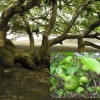 This poisonous tree is native to southern Florida, the Keys, many of the Caribbean islands, Mexico, and Central America. Though it is poisonous to humans and many animals, iguanas are eat the fruit and sometimes live among the tree’s limbs. It’s found along the seacoasts and in brackish swamps where it grows among mangroves. Each leaf has a small gland where the leaf joins the stem. The bark is reddish-to-grayish brown and cracked looking. Flowers inconspicuous, but the spikes or leafless stems that the flowers emerge from are visible. The fruit is bright-green and looks like a small apple. This 2-page fact sheet was written by Michael G. Andreu and Melissa H. Friedman, and published by the UF Department of School of Forest Resources and Conservation, July 2012.
This poisonous tree is native to southern Florida, the Keys, many of the Caribbean islands, Mexico, and Central America. Though it is poisonous to humans and many animals, iguanas are eat the fruit and sometimes live among the tree’s limbs. It’s found along the seacoasts and in brackish swamps where it grows among mangroves. Each leaf has a small gland where the leaf joins the stem. The bark is reddish-to-grayish brown and cracked looking. Flowers inconspicuous, but the spikes or leafless stems that the flowers emerge from are visible. The fruit is bright-green and looks like a small apple. This 2-page fact sheet was written by Michael G. Andreu and Melissa H. Friedman, and published by the UF Department of School of Forest Resources and Conservation, July 2012.
http://edis.ifas.ufl.edu/fr370
Fortunella spp., Kumquat (FOR300/FR368)
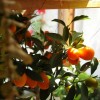 Many people find kumquat trees attractive and useful yard specimens. Their dark green leaves and contrasting bright orange fruits give them ornamental quality, and their relatively small size makes them easy to care for once they’re established. Because kumquats generally require less care than other citrus trees, they may be a good choice for gardeners with less time or experience, but who still desire an attractive and tasty citrus tree. If space is an issue, kumquats also do well in containers as long as they receive proper sunlight and watering. This 2-page fact sheet was written by Michael G. Andreu, Melissa H. Friedman, and Robert J. Northrop, and published by the UF Department of School of Forest Resources and Conservation, July 2012.
Many people find kumquat trees attractive and useful yard specimens. Their dark green leaves and contrasting bright orange fruits give them ornamental quality, and their relatively small size makes them easy to care for once they’re established. Because kumquats generally require less care than other citrus trees, they may be a good choice for gardeners with less time or experience, but who still desire an attractive and tasty citrus tree. If space is an issue, kumquats also do well in containers as long as they receive proper sunlight and watering. This 2-page fact sheet was written by Michael G. Andreu, Melissa H. Friedman, and Robert J. Northrop, and published by the UF Department of School of Forest Resources and Conservation, July 2012.
http://edis.ifas.ufl.edu/fr368
Gleditsia aquatica, Water Locust (FOR301/FR369)
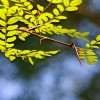 Water locust’s wide, spreading root system and affinity for hydric conditions makes it a useful specimen for erosion control on wet banks of freshwater systems. While not widely available, planting this tree in residential yards or other public locations may be less than ideal, since the long and sharply pointed thorns on the main trunk and branches can be hazardous. This deciduous tree is native to Florida. This 2-page fact sheet was written by Michael G. Andreu, Melissa H. Friedman, and Robert J. Northrop, and published by the UF Department of School of Forest Resources and Conservation, July 2012.
Water locust’s wide, spreading root system and affinity for hydric conditions makes it a useful specimen for erosion control on wet banks of freshwater systems. While not widely available, planting this tree in residential yards or other public locations may be less than ideal, since the long and sharply pointed thorns on the main trunk and branches can be hazardous. This deciduous tree is native to Florida. This 2-page fact sheet was written by Michael G. Andreu, Melissa H. Friedman, and Robert J. Northrop, and published by the UF Department of School of Forest Resources and Conservation, July 2012.
http://edis.ifas.ufl.edu/fr369
Leucaena leucocephala, White Leadtree (FOR299/FR367)
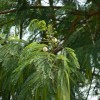 In Florida, white leadtree is a prohibited species and therefore is not used in commercial applications in the state. However, in its native range it is used as a source of charcoal, fuel, and lumber. It has also been planted as a windbreak for crops such as coffee and cocoa, and some ranchers use the tree as a source of both shade and forage for cattle, with the pods being an excellent source of protein. In addition, as white leadtree forms a well-developed taproot, it has been planted to assist with erosion control. This 2-page fact sheet was written by Michael G. Andreu, Melissa H. Friedman, and Robert J. Northrop, and published by the UF Department of School of Forest Resources and Conservation, July 2012.
In Florida, white leadtree is a prohibited species and therefore is not used in commercial applications in the state. However, in its native range it is used as a source of charcoal, fuel, and lumber. It has also been planted as a windbreak for crops such as coffee and cocoa, and some ranchers use the tree as a source of both shade and forage for cattle, with the pods being an excellent source of protein. In addition, as white leadtree forms a well-developed taproot, it has been planted to assist with erosion control. This 2-page fact sheet was written by Michael G. Andreu, Melissa H. Friedman, and Robert J. Northrop, and published by the UF Department of School of Forest Resources and Conservation, July 2012.
http://edis.ifas.ufl.edu/fr367
Cassia afrofistula, Kenyan Cassia (FOR296/FR364)
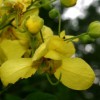 The Kenyan cassia can be used as a showy ornamental tree or shrub, with its dark foliage and bright yellow flowers. Some people find the seed pods to be unattractive and prune the tree after it flowers to prevent pods from developing. This tree tolerates a wide range of soil types and can be used in a garden, park, patio, or streetscape setting. This 2-page fact sheet was written by Michael G. Andreu, Melissa H. Friedman, and Robert J. Northrop, and published by the UF Department of School of Forest Resources and Conservation, July 2012.
The Kenyan cassia can be used as a showy ornamental tree or shrub, with its dark foliage and bright yellow flowers. Some people find the seed pods to be unattractive and prune the tree after it flowers to prevent pods from developing. This tree tolerates a wide range of soil types and can be used in a garden, park, patio, or streetscape setting. This 2-page fact sheet was written by Michael G. Andreu, Melissa H. Friedman, and Robert J. Northrop, and published by the UF Department of School of Forest Resources and Conservation, July 2012.
http://edis.ifas.ufl.edu/fr364
Cassia leptophylla, Gold Medallion Tree (FOR295/FR363)
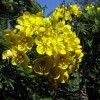 The gold medallion tree is planted primarily as a shade tree or as a decorative specimen for the yard or street. Many people like this tree because of its fast growth rate and showy, bright yellow clusters of flowers that bloom in the summer months. This tree loses its leaves for a very short period each year, but leaves are quickly replaced. Pruning the tree to one main leading stem from which major branches are attached can help increase its strength and sturdiness against strong wind events. The golden medallion tree is also naturally pest resistant, and as long as it is grown in areas where the temperature does not drop below freezing, it is an easy tree to care for. This 2-page fact sheet was written by Michael G. Andreu, Melissa H. Friedman, and Robert J. Northrop, and published by the UF Department of School of Forest Resources and Conservation, July 2012.
The gold medallion tree is planted primarily as a shade tree or as a decorative specimen for the yard or street. Many people like this tree because of its fast growth rate and showy, bright yellow clusters of flowers that bloom in the summer months. This tree loses its leaves for a very short period each year, but leaves are quickly replaced. Pruning the tree to one main leading stem from which major branches are attached can help increase its strength and sturdiness against strong wind events. The golden medallion tree is also naturally pest resistant, and as long as it is grown in areas where the temperature does not drop below freezing, it is an easy tree to care for. This 2-page fact sheet was written by Michael G. Andreu, Melissa H. Friedman, and Robert J. Northrop, and published by the UF Department of School of Forest Resources and Conservation, July 2012.
http://edis.ifas.ufl.edu/fr363
Cassia grandis, Pink Shower (FOR294/FR362)
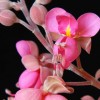 The name “pink shower” comes from the bright pink blossoms that this tree produces. It is sometimes called “stinking tree” because the pulp in its pods has a very strong smell. This 2-page fact sheet was written by Michael G. Andreu, Melissa H. Friedman, and Robert J. Northrop, and published by the UF Department of School of Forest Resources and Conservation, July 2012.
The name “pink shower” comes from the bright pink blossoms that this tree produces. It is sometimes called “stinking tree” because the pulp in its pods has a very strong smell. This 2-page fact sheet was written by Michael G. Andreu, Melissa H. Friedman, and Robert J. Northrop, and published by the UF Department of School of Forest Resources and Conservation, July 2012.
http://edis.ifas.ufl.edu/fr362
Callistemon salignus, White Bottlebrush (FOR292/FR360)
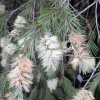 Native to Australia, this evergreen tree has use as an ornamental tree that produces moderate shade along a street, median, or yard. The unique flowering structure is eye-catching and it can be pruned for use as a decorative hedge. Its tolerance of many different soil types and droughty conditions makes it easy to care for after it’s been established. This 2-page fact sheet was written by Michael Andreu, Melissa Friedman, Robert Northrop, and published by the UF Department of School of Forest Resources and Conservation, July 2012.
Native to Australia, this evergreen tree has use as an ornamental tree that produces moderate shade along a street, median, or yard. The unique flowering structure is eye-catching and it can be pruned for use as a decorative hedge. Its tolerance of many different soil types and droughty conditions makes it easy to care for after it’s been established. This 2-page fact sheet was written by Michael Andreu, Melissa Friedman, Robert Northrop, and published by the UF Department of School of Forest Resources and Conservation, July 2012.
http://edis.ifas.ufl.edu/fr360